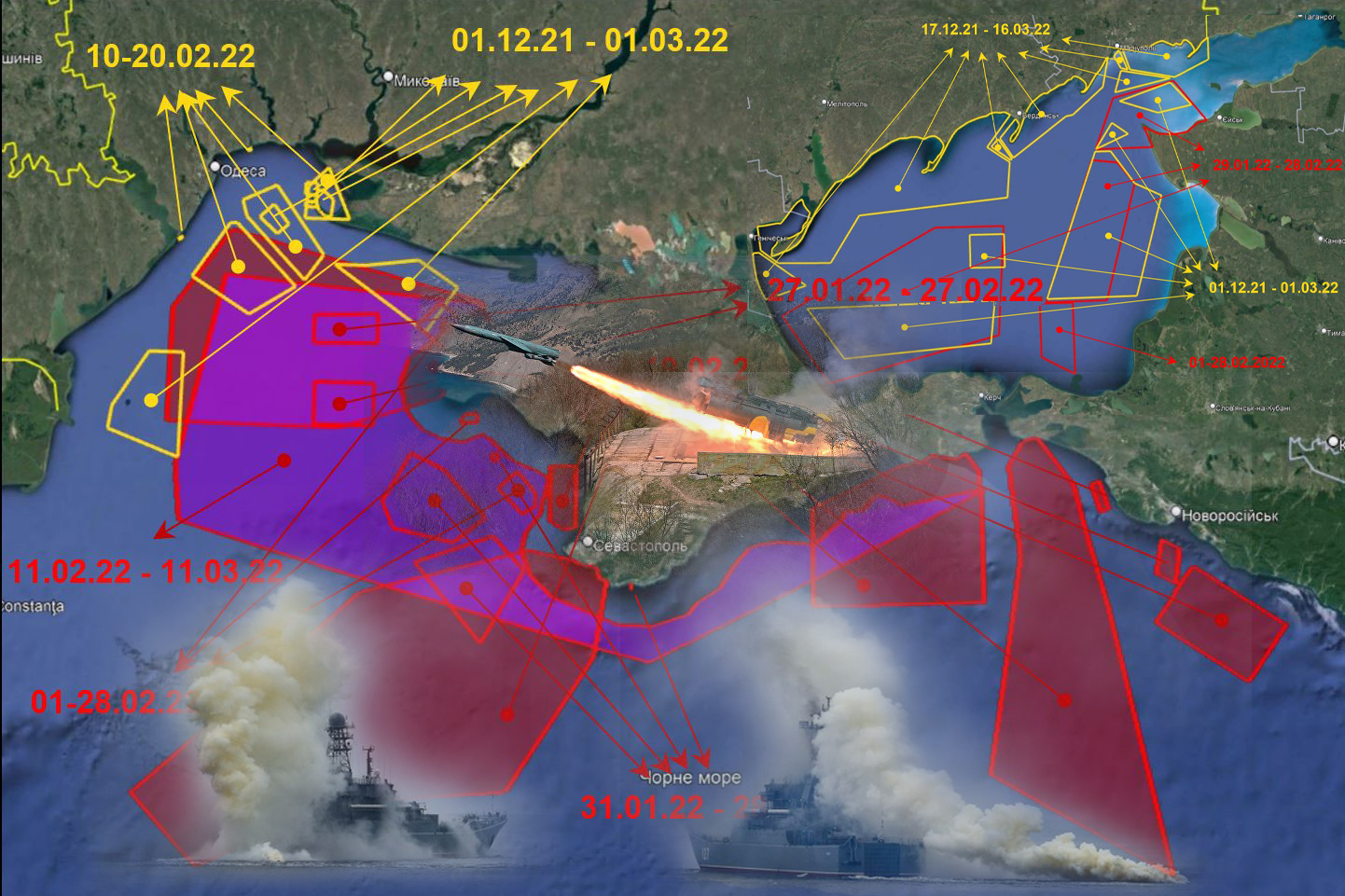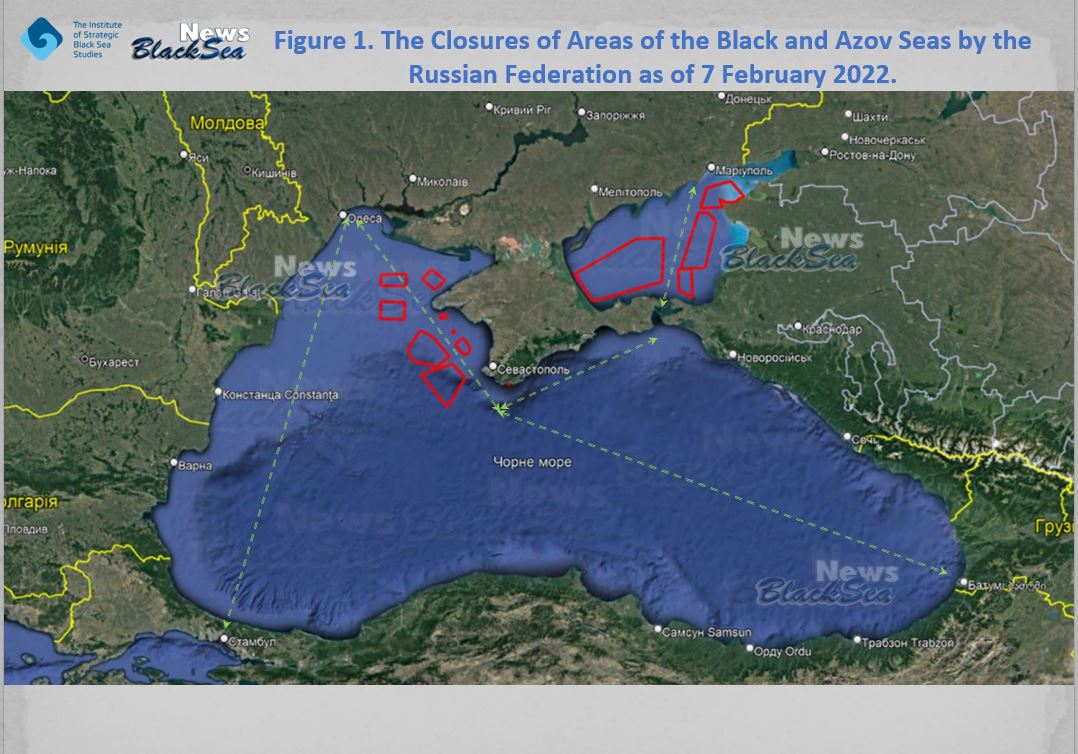Increased Risks. Obstruction of Traffic in the Black and Azov Seas by Russia due to the Closure of Sea Areas for Military Exercises as of 15 February 2022

The Monitoring Group of BlackSeaNews
and the Black Sea Institute of Strategic Studies
This analytical review presents the results and conclusions made by the Monitoring Group of Black Sea Institute of Strategic Studies and the editorial board of BlackSeaNews based on monitoring in January-February 2022 the following area: Obstruction of traffic in the Black Sea and the Sea of Azov by the Russian Federation due to closures of sea areas for or under the pretext of military exercises.
In January and early February 2022, up to and including 7 February 2022, the closures of the areas of the Black and Azov Seas for naval exercises by the Russian Federation were usual and even almost minimal, compared to the situation in December 2021, on which we reported earlier.

Note that Figure 1 clearly shows that the closure of sea areas was carried out in such a way as not to create obstacles to the traffic of civilian vessels following the recommended direction of traffic flow marked with arrows.
The recommended direction of traffic flow is a maritime navigation term, which means the course of a ship that is safe in terms of navigation and the most advantageous for a given season and specific ports of departure and arrival. The recommended direction of traffic flow ensures an ocean (sea) passage not only in the safest way but also in the shortest time. The recommended direction of traffic flow is usually indicated in guidance documents and guides for navigators and ship captains.
The situation changed dramatically on 8 February 2022, when the Russian Federation issued a navigational message about the closure of huge areas of the Black and Azov Seas (see Figure 2) for the period from 13 to 19 February 2022 inclusive.
As Figure 2 shows, the announced areas of missile and gunnery firing exercises cover the recommended direction of traffic flow to/from the ports of Ukraine in both the Black and Azov Seas.
Blocked Area 1 in the Black Sea and Area 2 in the Sea of Azov present the greatest danger for Ukraine – such complete closures are taking place for the first time in 8 years since 2014. They make shipping to/from all Ukrainian ports in the Black and Azov Seas virtually impossible (see details below).
Area 3 in the Black Sea is intended for missile firing. Russia's missile firing from this area of occupied Crimea takes place quite often and creates the risk of a missile accidentally hitting a civilian ship (such cases have occurred, see details below).
The next significant change in the situation took place on 10 February 2022, when the Russian Federation announced the cancellation of the closure of one area of the Sea of Azov (See Area 2 in Figure 2).
One of the possible reasons for this decision could be the strong reaction of Ukrainian and foreign media, the Ukrainian government, and diplomatic circles of Europe and America, as well as possible complaints from Russian shipowners, as the closure of this area made huge sea traffic of Russian ships to/from the Kerch Strait to/from the ports of the Don and Volga rivers impossible.
Figure 3 shows the situation as of 10 February 2022.
On 11 February 2022, the next major closures of the Black Sea areas by the Russian Federation occurred (See Figure 4).
On this day, a huge sea area was closed for one month, i.e. from 11 February to 11 March 2022 inclusive (See Area 4 marked in purple in Figure 4).
Note that this area (as has often happened in recent years) partially overlaps several other areas of the Black Sea that were previously closed by the Russian Ministry of Defence but does not cancel these earlier closures.
In addition, closed Areas 5, 6, 7, 8, and 9 were added to Areas 1 and 2. Area 5 is located near the coast of occupied Crimea, the rest of the areas – in the territorial sea and the maritime exclusive economic zone of the Russian Federation. Areas 6-9 are blocked for the same period as Areas 1 and 2 – i.e. from 13 to 19 February 2022 inclusive.
It should be noted that the State Hydrographic Service of Ukraine, Derzhhidrohrafiia, the only official body that issues, receives, publishes and distributes warnings about the dangers to shipping, was forced by international rules to spread this warning, but added an unprecedented text:
"IN CONNECTION WITH NAVAL TRAINING OF RUSSIAN FEDERATION WITHIN EXCLUSIVE MARITIME ECONOMIC ZONE OF UKRAINE AGAINST THE WILL OF UKRAINE AT NAVIGATION IN AREA BOUNDED BY [the coordinates follow] MARINERS SHOULD EXERCISE EXTREME CAUTION."
On the same day, 11 February 2022, Russia announced a major exercise of its Black Sea Fleet. The purpose of this exercise of the Russian Navy is noteworthy.
"The purpose of the exercise is to defend the sea coast of the Crimean Peninsula, the bases of the forces (troops) of the Black Sea Fleet, as well as facilities of the country's economic sector, maritime communications, and areas of maritime economic activity from possible military threats of the opposing force.
More than 30 warships of various classes from the Black Sea and other fleets are involved in performing tasks as part of all-arms forces, attack groups, and squadrons of landing ships. Among them are frigates, patrol ships, small missile ships and missile boats, landing ships, small anti-submarine ships, as well as mine countermeasures vessels."
Note that according to volunteers of the Monitoring Group, in reality, as of the evening of 13 February 2022, a large number of Russian warships was not observed in the areas of "maritime economic activity" – i.e. in the areas where Ukrainian offshore gas platforms, seized by Russia during the occupation of Crimea in February 2014, are located: on the sea shelf between the Crimean Peninsula and the coast of the Odesa region. That is, exercises were not actually conducted there.
Why then close the sea area if the Russian military is not doing anything special there? According to naval experts, in such a way, the Russian Black Sea Fleet can hide from prying eyes the areas of concentration of naval groups and the passage of landing ships involved in this exercise (as follows from the above quote).
Moreover, for the announced purpose of the exercise, namely the defence of "the sea coast of the Crimean Peninsula, the bases of the forces (troops) of the Black Sea Fleet, as well as facilities of the country's economic sector, maritime communications, and areas of maritime economic activity," the presence of landing ships appears surprising.
Obviously, the Ukrainian Navy could not help but react to this situation. They were forced to close shipping areas near strategically important passages to Ukrainian ports. However, during such closures, shipping is usually not completely restricted.
In such areas, ships and boats of the Navy and the Sea Guard of the Border Guard Service of Ukraine carry out patrolling and warn commercial vessels of the need to be vigilant and careful. During firing exercises, the Ukrainian Navy usually prohibits navigation for only a few hours.
Beginning in July 2019, a phenomenon emerged in the Black and Azov Seas, which we called the "war of exercises."
See the background and details in our analytical review The "War of Exercises" in the Black Sea: A New Very Dangerous Stage that Cannot Be Ignored.
On 13 January 2020, in the article The (Un)foreseen Storm-2 – From Crimea to Odesa. Maritime Risks in 2020: The Black Sea, we published our forecast: "In 2020, one of the Russian methods for obstructing navigation in the Black Sea will be the expansion of the practice of closing the western regions of the sea for navigation under the pretext of conducting live-fire exercises, whether real or make-believe."
The "war of exercises" or the "war of closures" of sea areas for training is the situation where the coordinates of the areas of exercises and missile and gunnery firing of Russia's Black Sea Fleet regularly and systematically overlap with the coordinates of sea areas that were previously closed for naval exercises of the Ukrainian Navy.
The maps below show this situation (the duration of closures is specified). Naturally, this does not contribute to shipping safety.
* * *
More on the topic
- 04.11.2023 Deployment of Russian Warships in the Mediterranean as of November 1, 2023
- 31.05.2023 Deployment of Russian Warships in the Mediterranean as of May 31, 2023
- 06.11.2022 The presence of Russian warships in the Mediterranean Sea as of 6 November 2022
- 12.10.2022 The Presence of Russian Warships in the Mediterranean Sea as of 10 October 2022
- 16.09.2022 The Presence of Russian Warships in the Mediterranean Sea as of 15 September 2022
- 11.05.2022 The Presence of Russian Warships in the Mediterranean Sea as of 10 May 2022
- 09.03.2022 The Presence of Russian Warships in the Mediterranean Sea as of 9 March 2022
- 01.02.2022 The Presence of Russian Warships in the Black Sea and the Mediterranean Sea in January 2022
- 20.12.2021 International Security Risks in the Azov-Black Sea Region in November-December 2021
